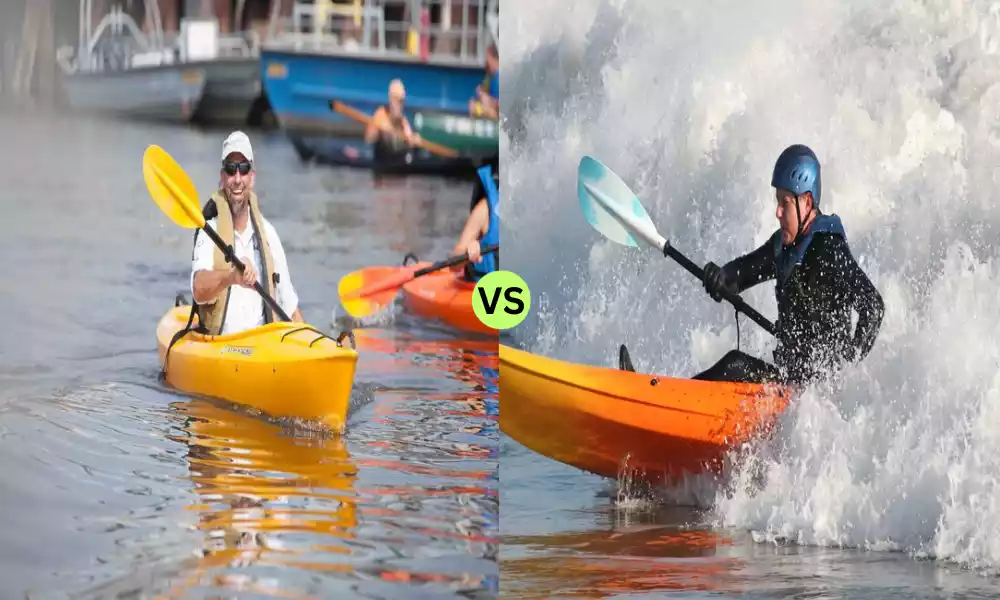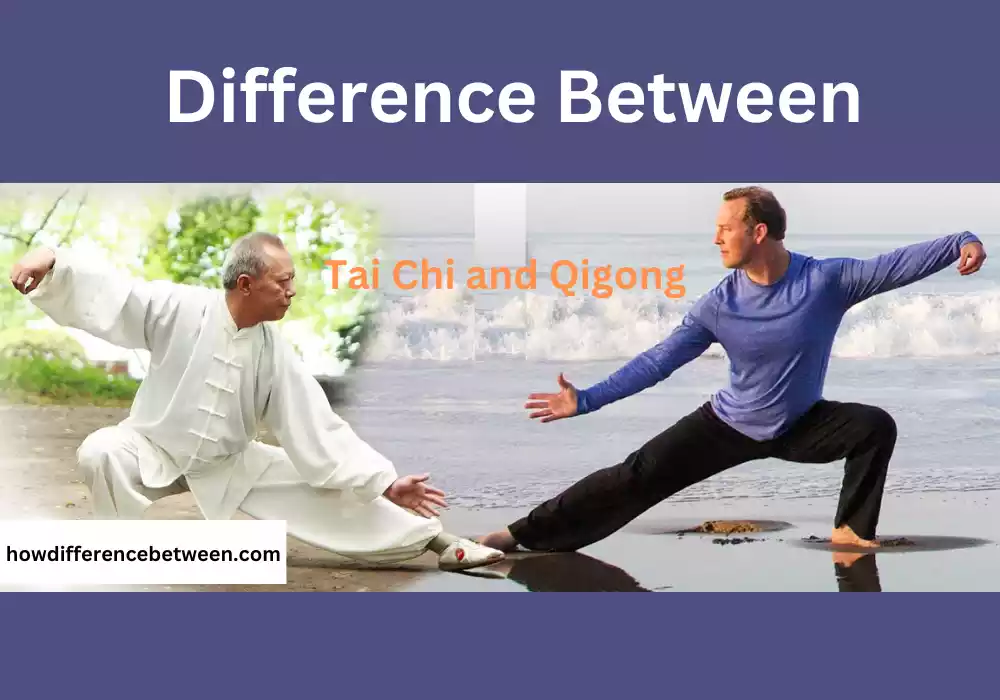Kayaking and Canoeing are both exhilarating water sports that have ancient origins, rooted in the daily lives and survival of indigenous cultures. While they share the thrill of paddling on water, they are distinct in design, technique, and purpose.
Kayaks, with their enclosed cockpits and streamlined forms, are reminiscent of the Arctic hunters navigating icy waters, while canoes, with their open-top design, evoke images of trade routes, serene lake crossings, and ceremonial journeys.
Both offer unique experiences on the water, whether it’s the adrenaline rush of navigating rapids or the peacefulness of a calm lake paddle, but understanding their differences is key to enjoying each to its fullest.
Definition of Kayaking
Kayaking is a water activity that involves paddling using a double-bladed oar and a small boat known as a kayak. Kayaks typically have a closed-deck design with one or more cockpits, seating the paddler in a forward-facing position with their legs extended in front.
Kayaking can be done on various water bodies, including rivers, lakes, seas, and oceans, and it encompasses a range of styles from tranquil and recreational paddling to adrenaline-filled whitewater kayaking and sea expeditions. The sport’s origins trace back to the indigenous Arctic cultures, where it was primarily used for hunting and transportation.
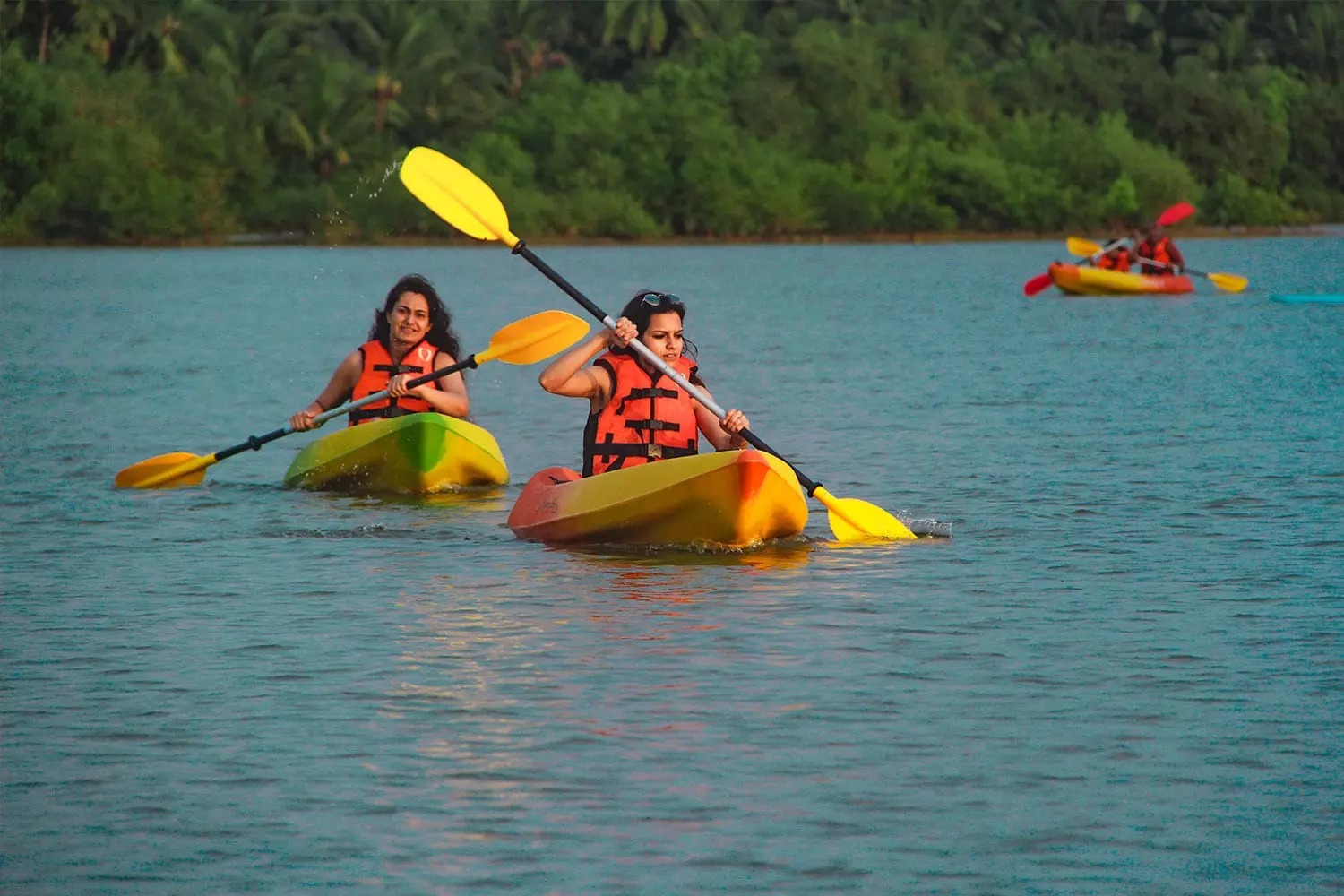
Definition of Canoeing
Canoeing is a water-based activity where participants paddle a canoe with a single-bladed paddle. Canoes are open vessels, usually designed to accommodate one or more passengers and often characterized by their higher sides and broad, flat bottom. Canoeing can take place across diverse environments, from calm lakes and rivers to challenging whitewater rapids. Historically significant in various cultures worldwide, canoes have served as essential tools for transportation, trade, and ceremonial activities. In modern times, canoeing encompasses both recreational journeys and competitive racing.
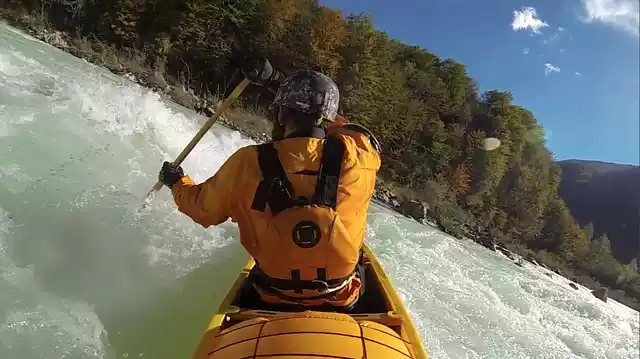
Physical Features of Kayaking and Canoeing
Physical Features of Kayaking and Canoeing
- Craft Design:
- Kayak:
- Generally closed-deck, meaning the paddler sits inside a cockpit.
- Low to the water, often with a sleek, streamlined design.
- Can have one or more cockpits (e.g., tandem kayaks).
- Canoe:
- Open-deck, allowing for more cargo or additional passengers.
- Higher sides (gunwales) and a more elevated position in the water.
- Wider and can be longer than most kayaks.
- Kayak:
- Seating:
- Kayak:
- Paddler sits low, with legs extended forward.
- Seat often comes with back support and is positioned inside the cockpit.
- Canoe:
- Paddler either kneels or sits on a raised bench or seat.
- Provides a higher vantage point compared to a kayak.
- Kayak:
- Paddle:
- Kayak:
- Typically uses a double-bladed paddle.
- Paddler alternates strokes on either side of the kayak.
- Canoe:
- Typically uses a single-bladed paddle.
- Paddler may switch sides or use specific techniques to maintain a straight path.
- Kayak:
- Storage:
- Kayak:
- Equipped with watertight compartments or hatches for gear storage.
- Some models have bungee cord systems on the deck for securing items.
- Canoe:
- Open design allows for more significant storage capacity.
- Gear is often stored in waterproof bags or containers to prevent water damage.
- Kayak:
- Stability and Maneuverability:
- Kayak:
- Typically more responsive and easier to maneuver due to its design and low center of gravity.
- Different designs cater to various environments, e.g., whitewater, sea, or flatwater kayaks.
- Canoe:
- Generally more stable, especially flat-bottomed designs.
- Can be harder to turn quickly but tracks straighter on long courses.
- Kayak:
- Safety and Self-Rescue:
- Kayak:
- In case of capsizing, techniques like the Eskimo roll can be used to right oneself.
- Spray skirts can be used to prevent water from entering the cockpit.
- Canoe:
- Less likely to become waterlogged, but harder to flip upright and re-enter after capsizing.
- Water can be bailed out or canoes can be swamped to the shore in case of capsizing.
- Kayak:
While kayaks and canoes have some overlapping features, they possess distinct physical attributes tailored to different uses, environments, and preferences.
Purposes and Uses
Purposes and Uses of Kayaking and Canoeing Both kayaking and canoeing have versatile applications, ranging from recreational to professional. Here’s a breakdown of their purposes and uses:
1. Recreation:
- Kayak:
- Sea Kayaking: Exploring coastal waters, bays, and estuaries.
- Recreational Kayaking: Casual paddling on calm lakes and slow-moving rivers.
- Whitewater Kayaking: Navigating rapid waters and challenging terrains.
- Surf Kayaking: Playing in the breaking waves along beaches.
- Canoe:
- Recreational Canoeing: Paddling on calm lakes or slow rivers, often preferred for family outings.
- Whitewater Canoeing: Similar to whitewater kayaking but in a canoe, requiring different techniques.
2. Expedition and Touring:
- Kayak:
- Touring Kayaks: Designed for longer trips with storage capacity for camping gear.
- Canoe:
- Touring Canoes: Suitable for multi-day trips, often with greater storage capacity for equipment and provisions.
3. Fishing:
- Kayak:
- Fishing Kayaks: Equipped with rod holders, storage, and other fishing-related amenities. Provides stealthy access to fishing spots.
- Canoe:
- Canoes offer a stable platform and ample storage space, making them suitable for fishing, especially in calm waters.
4. Sport and Competition:
- Kayak:
- Slalom Kayaking: Navigating through a rapid river course set with gates.
- Sprint Kayaking: Racing on flat water over different distances.
- Polo: Team game played on water with a ball, similar to water polo but in kayaks.
- Canoe:
- Canoe Sprints: Flatwater racing similar to sprint kayaking.
- Canoe Slalom: Racing through a rapid river course, like slalom kayaking.
- Marathon: Long-distance canoe races.
5. Fitness and Exercise:
- Both kayaking and canoeing offer excellent aerobic workouts and can help improve strength, endurance, and flexibility.
6. Transportation:
- Canoe:
- Historically, canoes were used by indigenous peoples for transportation, trade, and hunting across water bodies.
- Still used in some remote communities as primary means of water transport.
7. Wildlife Watching and Photography:
- Both kayaking and canoeing offer quiet modes of transportation, making them ideal for observing wildlife in aquatic environments without causing disturbance.
8. Therapy and Rehabilitation:
- Both activities can be used for physical and mental therapy. The rhythmic paddling motions and the tranquility of water can have therapeutic effects.
Both kayaking and canoeing cater to diverse needs, from leisurely paddles to adrenaline-packed adventures. Their versatility ensures they remain popular and cherished outdoor activities across various cultures and regions.
Comparison table of Kayaking and Canoeing
There are comparison table of kayaking and canoeing:
| Feature | Kayaking | Canoeing |
|---|---|---|
| Design | Enclosed deck, typically with one or more cockpits | Open vessel, usually with higher sides |
| Paddle Type | Double-bladed | Single-bladed |
| Seating Position | Seated with legs extended forward | Seated on a bench or thwart, or kneeling |
| Origin | Indigenous Arctic cultures | Indigenous cultures worldwide |
| Main Uses (Historical) | Hunting and transport in Arctic regions | Trade, transportation, and ceremonies |
| Main Uses (Modern) | Recreational, sea kayaking, whitewater, fishing | Recreational, expedition, whitewater, racing |
| Storage | Limited due to enclosed design | Generally more space due to open design |
| Maneuverability | Highly maneuverable, especially in whitewater | Versatile but can be less agile than kayaks |
| Stability | Varies; generally stable but can depend on design | Generally stable, especially in calm waters |
| Safety Techniques | Eskimo roll for self-righting | Brace strokes, and bilge-pumping for water removal |
| Common Materials (Modern) | Plastic, fiberglass, carbon-fiber | Wood, fiberglass, plastic, aluminum |
The distinctions made in this table are general and might not apply to all types of kayaks or canoes, as both have evolved and diversified over time. For example, there are now sit-on-top kayaks, and some canoes are designed specifically for rapid waters. Always research specific models and designs when considering either activity.
Best Destinations for Kayaking and Canoeing
Best Destinations for Kayaking and Canoeing
1. North America
- Boundary Waters Canoe Area Wilderness, Minnesota, USA: A pristine wilderness with over 1,000 miles of canoe routes.
- Colorado River, Grand Canyon, Arizona, USA: Experience thrilling rapids and serene flat waters in one of the world’s most iconic landscapes.
- San Juan Islands, Washington, USA: Ideal for sea kayaking, with opportunities to spot orcas, seals, and other marine life.
- Everglades National Park, Florida, USA: A network of mangroves, islands, and freshwater marsh ideal for multi-day trips.
2. Europe
- Sognefjord, Norway: Europe’s largest fjord offering breathtaking cliffs and waterfalls.
- Dordogne River, France: A historic route passing medieval castles, cliffs, and picturesque villages.
- Loch Lomond and the Trossachs, Scotland: Serene waters set against a backdrop of rolling hills and mountains.
- Croatian Coast: The Dalmatian coast offers crystal-clear waters, historic towns, and beautiful islands.
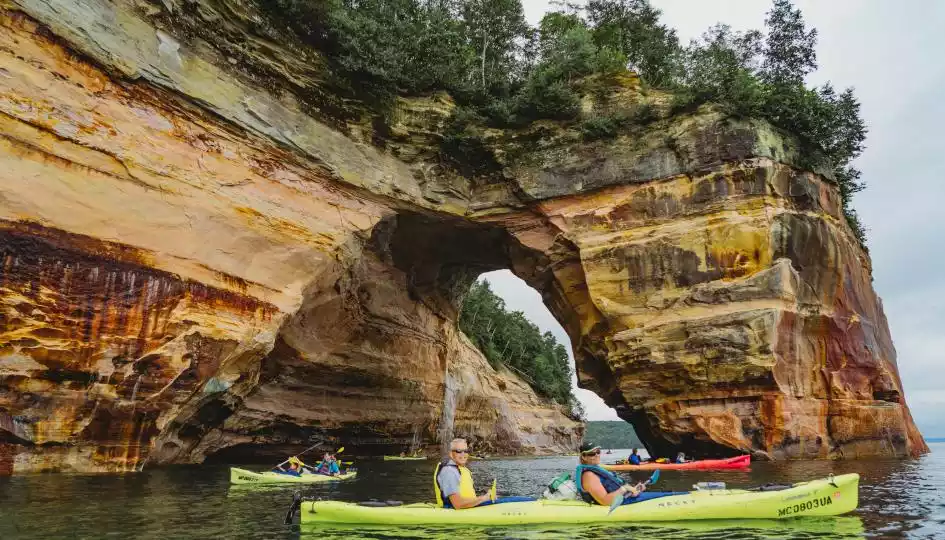
3. Oceania
- Milford Sound, New Zealand: Majestic waterfalls and dramatic cliffs in one of the country’s most iconic landscapes.
- Great Barrier Reef, Australia: Kayak amidst colorful coral formations and a diverse range of marine life.
- Whitsunday Islands, Australia: Turquoise waters, white sandy beaches, and coral reefs.
4. Asia
- Halong Bay, Vietnam: Thousands of limestone karsts and isles emerging from emerald waters.
- Kerala Backwaters, India: A labyrinth of waterways, offering a unique view of local life and tropical scenery.
- Phang Nga Bay, Thailand: Limestone caves, mangroves, and turquoise waters make this a kayaking paradise.
5. Africa
- Okavango Delta, Botswana: A vast inland delta with winding waterways and a diverse range of wildlife.
- Nile River, Egypt: Historical sites and warm waters make this an intriguing paddling experience.
- Tsitsikamma, South Africa: Coastal paddling with opportunities to see dolphins, seals, and other marine life.
6. South America
- Amazon Rainforest: Paddle through the world’s largest rainforest, encountering a rich diversity of plants and animals.
- Torres del Paine National Park, Chile: Glacier-fed rivers set against a backdrop of towering peaks and expansive blue ice fields.
- Galápagos Islands, Ecuador: Unique wildlife encounters, from marine iguanas to blue-footed boobies.
7. Central America and the Caribbean
- Belize Barrier Reef: Explore the second-largest coral reef system in the world, with clear waters and abundant marine life.
- Lake Atitlán, Guatemala: Surrounded by volcanoes and traditional Mayan villages.
- Baja Peninsula, Mexico: Sea kayaking with opportunities to spot whales, dolphins, and sea lions.
Whether you’re after a serene paddle on placid waters, an adrenaline-pumping whitewater experience, or marine adventures teeming with wildlife, the world is filled with fantastic destinations for kayaking and canoeing. Always remember to consider local safety guidelines, respect the environment, and hire a local guide if you’re unfamiliar with the area.
Safety Equipment and Accessories
Safety on the water is paramount, and equipping oneself with the proper safety gear and accessories can make all the difference in emergency situations.
1. Personal Flotation Devices (PFDs):
- Description: Life jackets or vests that provide buoyancy.
- Purpose: To keep the paddler afloat in the water and increase visibility. Some PFDs come with pockets and attachments for convenience.
2. Helmets:
- Description: Protective headgear.
- Purpose: Essential for whitewater kayaking or canoeing to protect the head from impacts with rocks or submerged objects.
3. Spray Skirts:
- Description: Flexible waterproof cover that seals the cockpit of a kayak.
- Purpose: Prevents water from entering the kayak, especially in rough conditions or during rolls.
4. Bilge Pumps and Sponges:
- Description: Tools to remove water.
- Purpose: To clear out any water that gets into the kayak or canoe. Sponges can soak up residual moisture.
5. Throw Bags/Rope:
- Description: Bags filled with buoyant rope.
- Purpose: For rescue purposes, especially in moving water. Can be thrown to a person in the water to pull them to safety.
6. Paddle Float:
- Description: Inflatable or foam device that attaches to a paddle.
- Purpose: Assists in self-rescue by stabilizing the kayak during a re-entry after capsizing.
7. Whistle or Signal Device:
- Description: Loud noise-making devices.
- Purpose: For attracting attention in case of emergency or to communicate with other paddlers.
8. Lights and Reflective Tape:
- Description: Illuminating and reflective devices.
- Purpose: Essential for visibility during dusk, dawn, or nighttime paddling. Helps in avoiding collisions and makes the paddler visible to rescuers.
9. Dry Bags:
- Description: Waterproof bags.
- Purpose: To keep gear, food, and clothing dry while paddling.
10. First Aid Kit:
- Description: A collection of medical supplies.
- Purpose: To treat minor injuries or stabilize major ones until professional medical help is available.
11. Communication Devices:
- Description: Waterproof VHF radios, satellite phones, or signaling mirrors.
- Purpose: For communication in case of emergencies or to stay informed about weather conditions.
12. Navigation Tools:
- Description: Compass, waterproof maps, GPS devices.
- Purpose: To navigate routes, especially in unfamiliar or large bodies of water.
13. Tow Lines:
- Description: Strong ropes or cords.
- Purpose: Allows one kayak or canoe to tow another in case of equipment failure or paddler fatigue.
14. Knife or Multi-tool:
- Description: Sharp tool, preferably with a blunt tip and a serrated edge.
- Purpose: Useful for emergency situations, such as cutting entangled ropes.
15. Sun Protection:
- Description: Sunglasses, wide-brimmed hats, and sunscreen.
- Purpose: Protects against sunburn and reduces glare.
In addition to the equipment listed, paddlers should always check local regulations and recommendations, as some areas might have specific safety requirements. Regular maintenance and checks of all equipment are also essential to ensure they function properly when needed.
Advantages and Disadvantages
Advantages and Disadvantages of Kayaking and Canoeing:
Advantages:
1. Health Benefits:
- Physical Workout: Both activities offer cardiovascular workouts, strengthening the heart and improving overall fitness. They also tone muscles, especially in the arms, shoulders, and core.
- Mental Health: The tranquility of being on the water can reduce stress, anxiety, and depression, promoting mental well-being.
2. Accessibility:
- Diverse Water Bodies: Both canoes and kayaks can be paddled on a variety of water bodies, from calm lakes to rapid rivers.
- Adaptable Skills: Beginners can start on calm waters, while experienced paddlers can navigate challenging environments.
3. Eco-Friendly:
- Low Impact: As non-motorized watercraft, they don’t emit pollutants and have minimal impact on aquatic ecosystems.
- Wildlife Watching: Their quiet nature allows paddlers to approach wildlife without causing much disturbance.
4. Versatility:
- Variety of Activities: From fishing to whitewater sports, the range of activities possible with kayaks and canoes is broad.
- Load Carrying: Canoes, in particular, can carry heavy loads, making them ideal for multi-day trips.
5. Community and Culture:
- Social Aspect: Paddling is often a communal activity, leading to strong bonds and friendships.
- Heritage: Especially with canoes, there’s a rich cultural and historical significance in many communities around the world.
Disadvantages:
1. Safety Concerns:
- Capsizing: Especially for beginners, there’s a risk of capsizing, which can be dangerous in cold or turbulent waters.
- Weather: Paddlers are exposed to the elements, which can quickly turn a pleasant outing into a challenging situation.
2. Physical Strain:
- Repetitive Motion Injuries: Continuous paddling can lead to injuries, especially if done without proper technique.
- Exhaustion: Overexertion, especially in challenging conditions, can lead to fatigue and potential danger.
3. Transport and Storage:
- Bulky: Both kayaks and canoes can be cumbersome, requiring roof racks for transportation and ample storage space.
- Maintenance: Regular checks and maintenance are required to ensure the equipment remains in good condition.
4. Cost:
- Initial Investment: Good quality kayaks and canoes, along with essential gear, can be pricey.
- Additional Expenses: Lessons, permits, maintenance, and accessories can add to the overall cost.
5. Environmental Concerns:
- Disturbance: Even though they’re low-impact, paddlers can still disturb wildlife if they don’t maintain a respectful distance.
- Over-Tourism: Popular paddling spots can get overcrowded, leading to environmental degradation.
While kayaking and canoeing have numerous benefits, from health to environmental advantages, they also come with certain drawbacks. As with any activity, understanding and addressing these challenges can lead to a more enriching and safe experience.
Cultural and Competitive Aspects
Cultural and Competitive Aspects of Kayaking and Canoeing
Cultural Aspects:
1. Historical Significance:
- Canoes: Have deep roots in indigenous cultures around the world, especially in North America, Polynesia, and parts of Africa and Australia. They were vital for transportation, trade, and fishing.
- Kayaks: Originated with the Inuit and Yupik peoples of the Arctic region. They were primarily used for hunting and fishing.
2. Cultural Symbolism:
- Canoes and kayaks often hold spiritual or symbolic significance in indigenous cultures. They can represent journeys, connections to nature, or traditional knowledge passed down through generations.
3. Craftsmanship:
- Building traditional canoes and kayaks is a revered skill in many cultures, often involving intricate designs and specific materials that have been passed down for generations.
4. Cultural Festivals and Celebrations:
- Many indigenous communities host canoe and kayak festivals or races that not only highlight the sporting aspect but also the cultural significance and traditions associated with these watercraft.
Competitive Aspects:
1. Olympic Sports:
- Kayaking and Canoeing: Both have been part of the Olympic Games since the mid-20th century. They include sprint events on flat water and slalom events on white water.
2. World Championships and International Competitions:
- Numerous global events cater to elite paddlers, like the ICF Canoe Sprint World Championships and the Canoe Slalom World Championships.
3. Specialized Competitions:
- Freestyle Kayaking: Athletes perform acrobatic tricks and maneuvers on standing waves or river features.
- Marathon Races: Long-distance canoe and kayak races that can stretch over several miles and may require portages (carrying the boat overland).
4. Club and University Competitions:
- Many countries have robust club cultures, where regional and national competitions are held. Universities may also have competitive canoe and kayak teams.
5. Extreme Competitions:
- For seasoned athletes looking for adrenaline, extreme kayaking events involve navigating steep and dangerous river sections or even waterfalls.
6. Development and Training Programs:
- National governing bodies in many countries offer development programs and training camps to nurture young talent and prepare them for international competitions.
The realms of kayaking and canoeing are deeply embedded in cultural histories and traditions of various communities. Simultaneously, they have evolved into modern competitive sports with a global following, encompassing a wide range of disciplines and events. Whether approached as a cultural practice or a competitive endeavor, both kayaking and canoeing enrich the human experience, bridging the past with the present.
Conclusion
Kayaking and canoeing are both rewarding water activities that immerse enthusiasts in nature, offering a unique blend of relaxation, adventure, and physical exercise. While they have distinct features and techniques, they share fundamental principles of safety and environmental stewardship. As with any outdoor activity, challenges arise, but with proper preparation and knowledge, these can be efficiently managed. Embracing the joys of paddling while upholding responsibilities ensures that waterways remain vibrant and accessible for future generations.

